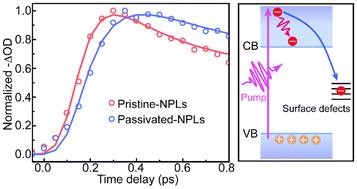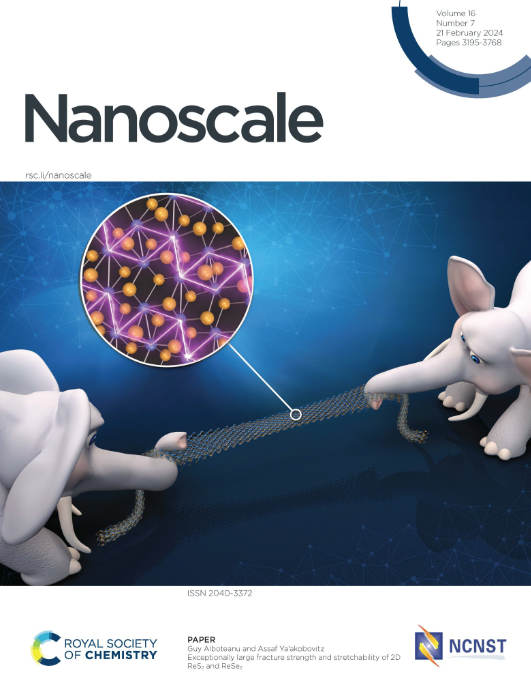Modulating hot carrier relaxation and trapping dynamics in lead halide perovskite nanoplatelets by surface passivation
IF 5.8
3区 材料科学
Q1 CHEMISTRY, MULTIDISCIPLINARY
引用次数: 0
Abstract
Two-dimensional (2D) lead halide perovskite (LHP) nanoplatelets (NPLs) have recently emerged as promising materials for solar cells and light-emitting devices. The reduction of LHP dimensions introduces an abundance of surface defects, which can strongly influence the photophysical properties of these materials. However, an insightful understanding of the effect of surface defects on hot carrier (HC) relaxation, one of the important properties of LHP NPLs, is still inadequate. Herein, the HC relaxation and trapping dynamics in pristine and surface passivated two-layer (2L) CsPbBr3 NPLs have been investigated by using time-resolved spectroscopy. The results reveal that surface defects can trap HCs directly before they relax to the band edge, which accounts for the absence of the hot-phonon bottleneck (HPB) effect in LHP NPLs. After healing surface defects with a passivation agent, the relaxation time of HCs is extended from ∼73 to ∼130 fs in 2L CsPbBr3 NPLs, indicating that the channel of HCs trapped by the surface defects can be effectively blocked. Accordingly, the HPB effect is activated in surface-passivated CsPbBr3 NPLs. The finding of surface defect-related HC relaxation dynamics is important for guiding the development of high-performance LHP NPL devices related to HCs through surface defect engineering.

通过表面钝化调节卤化铅过氧化物纳米片中的热载流子弛豫和捕获动力学
二维(2D)卤化铅过氧化物(LHP)纳米片(NPLs)最近已成为太阳能电池和发光器件的理想材料。LHP 尺寸的缩小带来了大量的表面缺陷,这些缺陷会严重影响这些材料的光物理特性。然而,人们对表面缺陷对热载流子(HC)弛豫的影响(LHP NPLs 的重要特性之一)仍然缺乏深入的了解。本文利用时间分辨光谱法研究了原始和表面钝化双层(2L)CsPbBr3 NPL 中的热载流弛豫和捕获动力学。研究结果表明,表面缺陷能在 HCs 松弛到带边缘之前直接捕获 HCs,这也是 LHP NPLs 中不存在热声子瓶颈(HPB)效应的原因。用钝化剂修复表面缺陷后,在 2L CsPbBr3 NPLs 中,HCs 的弛豫时间从 ∼73 fs 延长到 ∼130 fs,这表明被表面缺陷捕获的 HCs 通道可以被有效阻断。因此,在表面钝化的 CsPbBr3 NPL 中,HPB 效应被激活。与表面缺陷相关的碳氢化合物弛豫动力学的发现对于通过表面缺陷工程学开发与碳氢化合物相关的高性能低压NPL器件具有重要的指导意义。
本文章由计算机程序翻译,如有差异,请以英文原文为准。
求助全文
约1分钟内获得全文
求助全文
来源期刊

Nanoscale
CHEMISTRY, MULTIDISCIPLINARY-NANOSCIENCE & NANOTECHNOLOGY
CiteScore
12.10
自引率
3.00%
发文量
1628
审稿时长
1.6 months
期刊介绍:
Nanoscale is a high-impact international journal, publishing high-quality research across nanoscience and nanotechnology. Nanoscale publishes a full mix of research articles on experimental and theoretical work, including reviews, communications, and full papers.Highly interdisciplinary, this journal appeals to scientists, researchers and professionals interested in nanoscience and nanotechnology, quantum materials and quantum technology, including the areas of physics, chemistry, biology, medicine, materials, energy/environment, information technology, detection science, healthcare and drug discovery, and electronics.
 求助内容:
求助内容: 应助结果提醒方式:
应助结果提醒方式:


